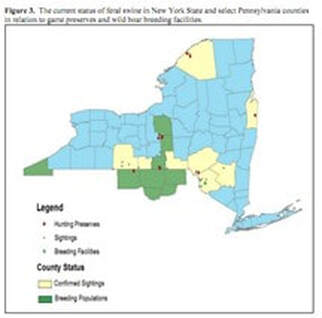 Natural History in the U.S. The first feral hogs were introduced in the 1800’s by settlers as a food source. Most of these introductions occurred in southern states, and the hogs quickly adapted to the wild. These pigs rapidly reproduced and colonized vast areas of the southern United States. Since then feral pigs have spread to or been released in at least twenty nine states, with more states possibly infested. The large majority of feral swine are descendants of domestic pigs, but there are also a growing number of escaped Eurasian wild boars and hybrid individuals. Most of these types escaped from hunting or breeding preserves, and are perfectly adapted to northern climates. Here in New York the recently discovered feral pigs seem to be of the Eurasian descent. The Department of Environmental Conservation claims they got out of several hunting preserves in the south central part of the state. They are now considered established in Onondaga, Cortland, and Tioga counties. Hogs have been considered established for about five years in the eyes of wildlife managers in New York State. These animals can range in size from 50 lbs, to almost 500 lbs depending on age and sex. The male hog; called a boar, tends to be the largest. These pigs can be brown or mottled, or if they have Eurasian genetics they can be black. The piglets sometimes have a striped appearance when they are very young. As is the case with most swine, feral hogs eat a variety of foods. These include; tubers, nuts, berries, crops, grasses, eggs, insects, and small animals. They can be found in many different habitats, from farmland to deep forests. Legal Status Most states where hogs are found view them as pests and a danger to wildlife populations. Most states allow them to be hunted year round with no limits because they are an invasive species. Here in New York, feral swine can be hunted year round as long as the hunter possesses a small game license. There is no limit on how many can be taken, or how they may be taken. They are considered a nuisance and are not protected. The one exception to this is that you cannot shoot them with a rifle during deer season where rifle hunting is not allowed. In general they are viewed as an urgent threat to the safety of New York’s lands and wildlife. Population Trends The population of feral hogs in the U.S. has done nothing but increase since their inception. Everywhere they exist, they have expanded in range and numbers. This is due to their adaptability and intelligence, as well as their ability to produce several litters of young a year. When they are persecuted by humans they become very secretive and nocturnal. Unfortunately they are almost impossible to control once established. Hogs as a Nuisance There are a whole slew of reasons why these creatures are considered nuisances in New York. Since they are not part of the natural ecosystem, they compete directly for food with native wildlife species. Secondly, hogs can do thousands of dollars’ worth of damage to farm crops with their rooting and digging habits. They can destroy ground nesting bird nests, amphibians, and rare plants. Diseases can be spread to domestic livestock species, and they can adversely affect natural forest regeneration. Lastly, hogs can cause erosion and water quality issues due to their destructive rooting habits. Agriculture
In the view of many, the main reason these guests are unwanted is due to their affinity for farm crops. They can decimate a farmer’s livelihood in even moderate numbers. Alabama has a large population of wild hogs, and their estimated damages from 2009 were $75 million dollars. States with larger populations had even higher damage estimates, and there’s no telling what large numbers of hogs could do to New York’s farms. Feral Hogs and Aircraft The research that was reviewed in this report did not turn up any actual collisions between hogs and aircraft. This does not mean they don’t pose a threat however. Due to their large body mass, they can cause severe damage to even larger planes, and should be managed accordingly if they are found on airports. Their rooting for food may attract some bird species that look for invertebrates in disturbed soil, such as crows and starlings. Management Techniques Feral hogs are notoriously hard to control. They can be trapped using large cage traps, but this usually doesn’t lead to population reduction because the pigs become wise to this method. Harassing the hogs with trained dogs can be somewhat effective, but there is danger involved to both the handlers and dogs. This also just pushes the hogs to new areas. The two most effective techniques are fencing them out, and lethal harvest of the hogs. Fencing can all but guarantee their exclusion from airports and other sensitive areas, as they cannot jump very high to clear fences. When pigs are observed in an area, an effective population tool can be hunting them. This can eliminate a certain portion of the population, but can still lead to smart hogs that are difficult to hunt. The easiest way to manage them is to not allow them to be brought into a new area! This eliminates the problem before it begins. Loomacres - 800-243-1462 Bringing Wildlife Management to a Higher Level ©
0 Comments
Leave a Reply. |
Sales & Marketing
|



 RSS Feed
RSS Feed